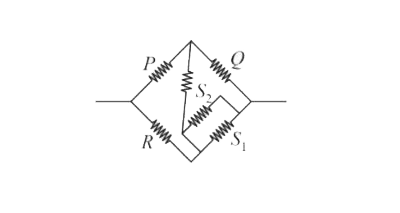Resistances P, Q, S and R are arranged in a cyclic order to form a balanced Wheatstone's network. The ratio of power consumed in the branches (P+Q) and (R+S) is
1:1
R:P
P2:Q2
P2:R2
The correct Answer is:B
For balanced Wheatstone,s bridge PQ=RS..(i)
Power dissipation in resistance R with voltage V is V^(2)//R<br>therefore (P_(P+Q))/(P_(R+S))=(R+S)/(P+Q)....(ii)<br>Fromequation(i)(P)/(Q)+1=(R)/(S)+1 Rightarrow (P+Q)/(Q)=(R+S)/(S) or (R+S)/(P+Q)=(S)/(Q)<br>Using(i).we≥t<br>(R+S)/(P+Q)=(R)/(P) therefore (P_(P+Q))/(P_(R+S))=(R)/(R)
Topper's Solved these Questions
- CURRENT ELECTRICITYBOOK - NCERT FINGERTIPSCHAPTER - CURRENT ELECTRICITYEXERCISE - Meter Bridge
4 Videos
- CURRENT ELECTRICITYBOOK - NCERT FINGERTIPSCHAPTER - CURRENT ELECTRICITYEXERCISE - Potentiometer
7 Videos
- CURRENT ELECTRICITYBOOK - NCERT FINGERTIPSCHAPTER - CURRENT ELECTRICITYEXERCISE - Kirchoff'S Law
11 Videos
- COMMUNITCATION SYSTEMSBOOK - NCERT FINGERTIPSCHAPTER - COMMUNITCATION SYSTEMSEXERCISE - HOTS
10 Videos
- DUAL NATURE OF RADIATION AND MATTER BOOK - NCERT FINGERTIPSCHAPTER - DUAL NATURE OF RADIATION AND MATTER EXERCISE - Assertion And Reason
15 Videos
Similar Questions
In a balanced wheatstone's network, the resistances in the arms Q and S are interchanged. As result of this:
View SolutionP,Q,R and S are the resistances taken in the cyclic order in a wheatstone bridge network. P and Q are ratio coils, S is the unknown resistance and R is a 20Ω coil. A balance is obtained when R is shunted with a resistance of 350Ω. When P and Q are interchanged, the balance is restored by altering the shunt across R to 498Ω. find the resistance of S and the ratio P:Q.
View Solution
Knowledge Check
Resistances P, Q, S and R are arranged in a cyclic order to form a balanced Wheatstone's bridge network. The ratio of power consumed in the branches (P+Q) and (R+S) is
A1:1BR:PCP2:Q2DP2:R2In a balanced wheatstone's network, the resistances in the arms Q and S are interchanged. As result of this:
Agalvanometer and the cell must be interchanged to balanceBgalvoanometer shows zero deflectionCnetwork is not balancedDnetwork is still balancedIf P=Q=R=10ΩandS=20Ω, then what resistance should be joined with S to balance the wheatstone's network ?
AJoin a resistance of 10Ω in series with SBJoin a resistance of 10Ω in parallel with SCJoin a resistance of 20Ω in parallel with SDJoin a resistance of 20Ω in series with S
P,Q,R and S are the resistances taken in cyclic order in a wheatstone bridge network. P and Q are the ratio coils, S is unknown resistance and R is a 10Ω coil. A balance is obtained when R is shunted with a resistance of 190Ω. When P and Q are interchanged, the balance is restored by altering the shunt across R to 265Ω. find the resitance of S and the ratio P:Q?
View SolutionFour resistors P, Q, R and S having resistances 3Ω,3Ω,4Ω and 6Ω respectively, are arranged to form a Wheatstone's bridge. The value of the resistance with which S must be shunted in order to balance the bridge is
View SolutionIn a Wheatstone bridge, three resistance, P, Q and R are connected in the three arms and fourth arm is formed by two resistance s1ands2 connected in parallel. The condition for the bridge to be balanced for ratio (pQ) is (given R=10Ω,S1=6Ω,S2=3Ω)

View SolutionIn a Wheatstone bridge, three resistance, P, Q and R are connected in the three arms and fourth arm is formed by two resistance s1ands2 connected in parallel. The condition for the bridge to be balanced for ratio (pQ) is (given R=10Ω,S1=6Ω,S2=3Ω)

View SolutionIn a Wheatstone bridge, three resistance, P, Q and R are connected in the three arms and fourth arm is formed by two resistance s1ands2 connected in parallel. The condition for the bridge to be balanced for ratio (pQ) is (given R=10Ω,S1=6Ω,S2=3Ω)

View Solution
